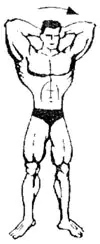- Tilt your head back with resistance
- Head tilt with resistance forward
- Side bends with resistance
- A bit of poetry...
- Training in specialized simulators
- Conclusion…
Tilt your head back with resistance
- Join your hands at the back of your head (fingers locked).
- Using your arms in the direction: “forward and down,” try to tilt your head to press your chin to your chest.
- At the same time, resist this movement with your neck muscles.
- Pressing your chin to your chest, using the strength of your neck muscles, overcoming the pressure of your hands (from the previous point), return your head to its original position.
- There's no need to rush. Don't make sudden movements. Do it as slowly as possible. Concentrate on the movement and your efforts.
Head tilt with resistance forward
- Place the palm of one hand on your chin, and with the other hand grab the elbow of your first hand. Or place both palms on your chin.
- From a position with your chin pressed to your chest, using your arms in the direction: “up and back,” try to straighten your head to a vertical position. At the same time, resist this movement with your neck muscles.
- Using your neck muscles, overcome the pressure of your hands on your chin and tilt your head.
- Perform at least three sets of 20 repetitions.
Side bends with resistance
Another less common variation of this exercise is the resistance side bend. In this case, counteraction is performed with only one hand, alternately on each side. Be extremely careful - side tilt is the most traumatic movement for your neck, its muscles and even your spine! Controlling movement here is very difficult and inconvenient - keep this in mind.
These exercises can be performed not only independently, but also with a partner. Commit resistance bending overcoming the efforts of the partner's hands. But remember, in this situation, you must exercise extreme caution, since any sudden movement or lack of coordination in actions can result in serious injury. Neck muscles do not like sudden movements! They are very easy to pull or tear.
The universal mass passion for fitness and bodybuilding since its inception has opened up vast horizons for business in this area. Like mushrooms after rain, a huge number of all kinds of manufacturers of sports equipment, equipment, equipment and even entire turnkey training complexes have appeared. In the era of weightlifting, of course, there was no such variety of techniques for bodybuilding. They used the good old barbell and dumbbells, and the available equipment was a novelty, and it was rare that a club could afford their impressive number and variety. Now, this increased growth of athletic equipment suppliers has also brought fierce competition into the market. Each company tries to be the best, each wants its products to be chosen by athletes, and with them the owners of fitness clubs and gyms. Such rivalry, of course, cannot please us, ordinary bodybuilders.
Firstly, in pursuit of a tasty morsel and more and more profits, manufacturers are now forced to listen to our opinion, creating increasingly high-quality, reliable, safe and easy-to-use simulators. Now everyone knows that “hackwork won’t work.” The buyer today will not take “just anything”, but will buy the best for himself...
The second positive aspect of this rivalry is that it forces competing firms to create more and more new simulators, come up with improved mechanisms, adapters and other sports technological innovations...
So it turns out that the total number of varieties of exercise equipment is constantly increasing, becoming more and more day by day. Already today, having visited a fairly serious gym, you will be able to find specialized training equipment there for pumping up the neck muscles, something that bodybuilders of Soviet times could not even dream of...
Training in specialized simulators
At their core they are analogues discussed by us in this article inclinations with resistance. The principle of their operation and the training methodology can be approximately described as follows:
- set the height, slope and position of the saddle you need,
- set the load you need,
- take a comfortable, stable position in the exercise machine,
- determine the direction of the load: front, rear, side,
- press the softening shock-absorbing pad onto the target area of the head,
- perform bends, overcoming the resistance created by the influence of the simulator.
Conclusion…
Still, the good old classic method is good simplicity And mobility. You don't need to go to the gym or have an expensive exercise machine at home... All you need is your hands and the desire to train. And this, you see, is a weighty argument!
And as always, final advice: “Don’t forget the old things! Even completely outdated methods can have their advantages..."
See below a video example of performing a variation of this exercise from the position: lying on your stomach with a barbell disc as a load:
v/a9DQS76i3Dg
If, after all of the above, you still have some questions or something is not clear, we strongly advise you to also watch this methodological video about neck training at home. We recommend!
v/Tl0FfLiJG9c
Post Views: 140


